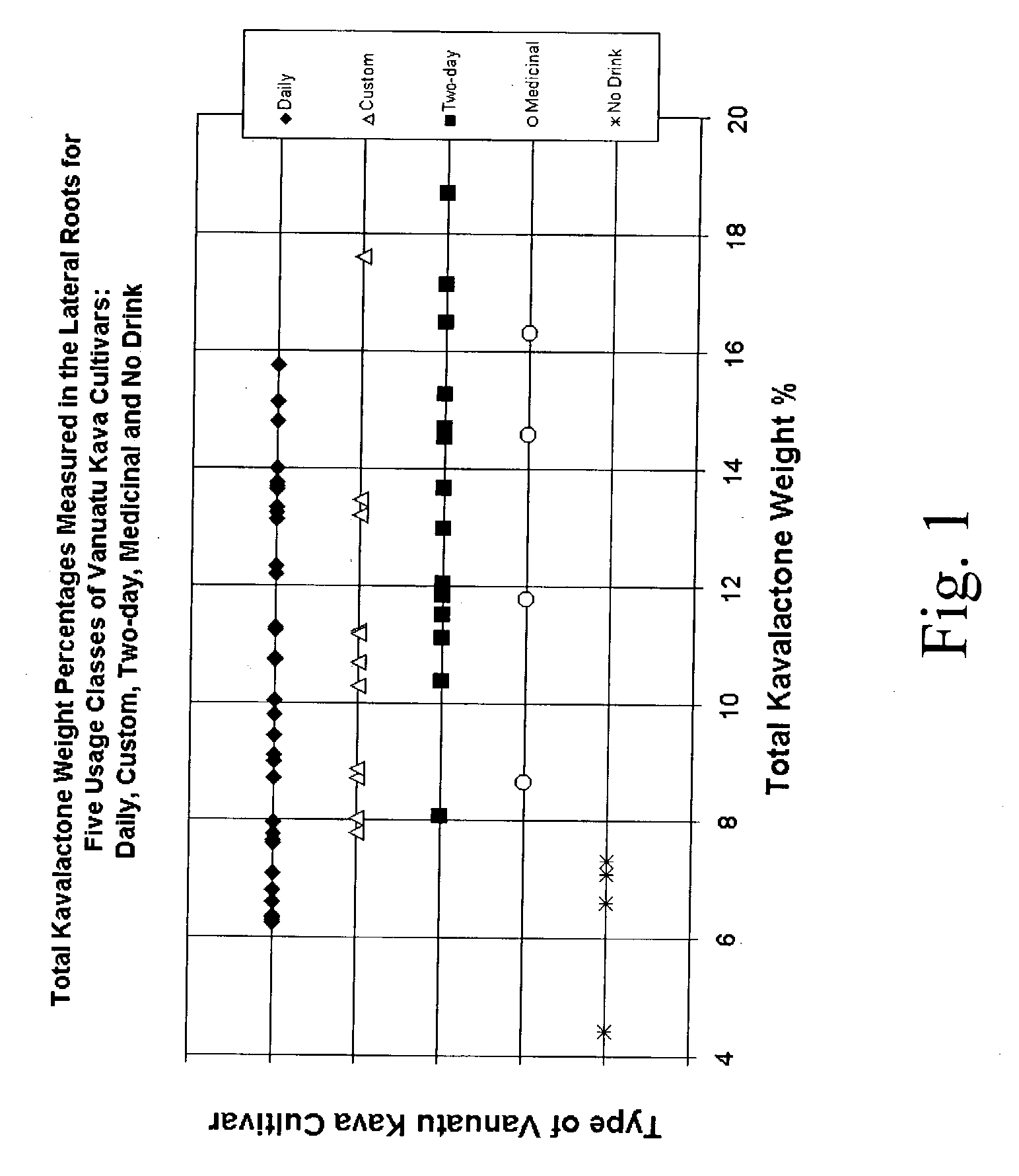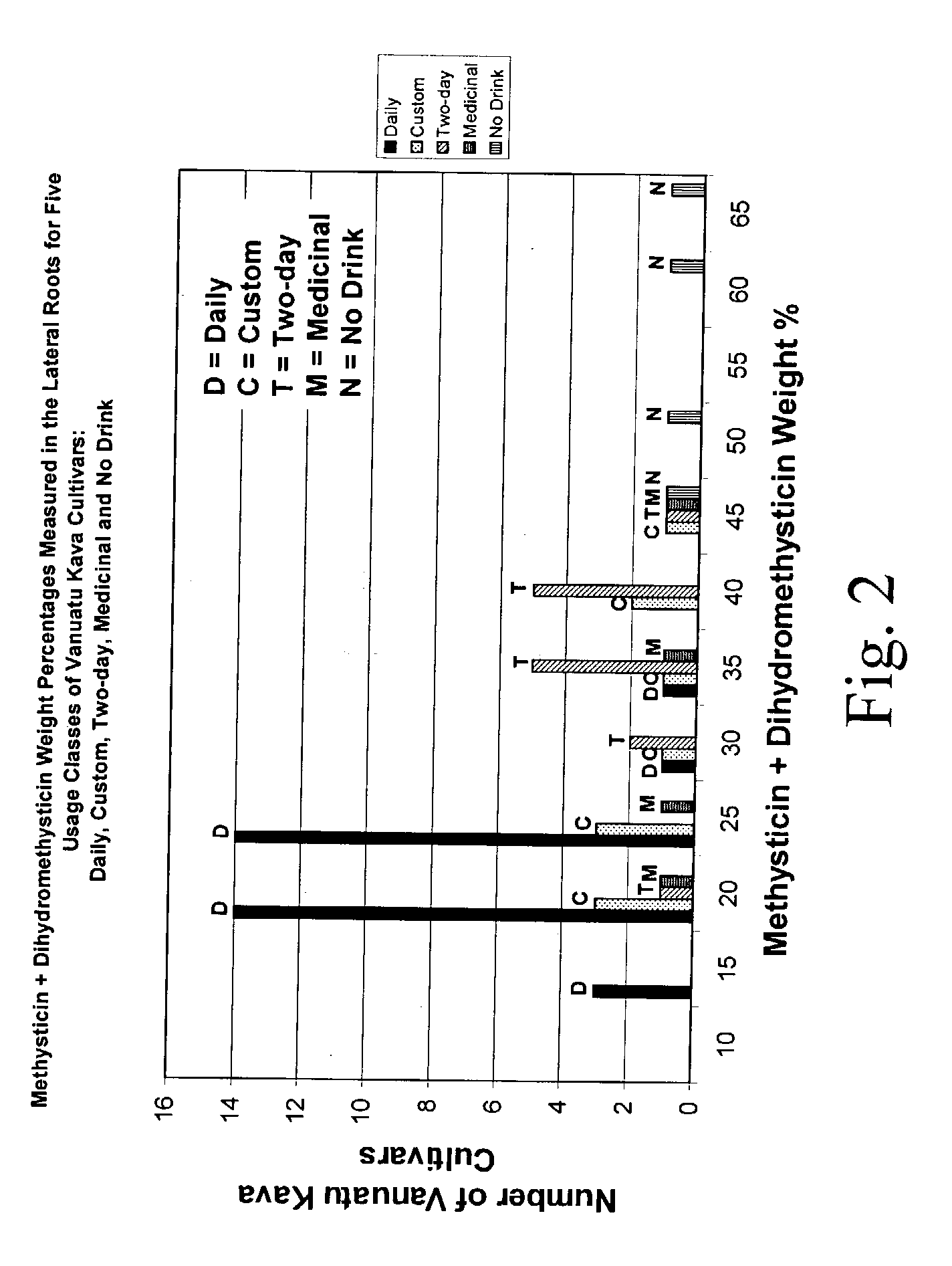Kavalactone product
a technology of kava and kava, which is applied in the direction of heterocyclic compound active ingredients, plant/algae/fungi/lichens ingredients, biocide, etc., can solve the problems of insufficient cultivation or availability of cultivars, inability to widely grow or produce them, and inability to reduce the negative effects of kava. to achieve the effect of enhancing the effect of kava and reducing the negative effects
- Summary
- Abstract
- Description
- Claims
- Application Information
AI Technical Summary
Benefits of technology
Problems solved by technology
Method used
Image
Examples
first embodiment
[0057] In the process, CO.sub.2 is used in the supercritical phase to perform the extraction step. The pressure is held at a pressure and temperature regime that between about 1100 psi and about 8000 psi and at a temperature between about 31.degree. C. and about 80.degree. C. During the process the extractable material is collected within a stainless steel collection vessel that could be the same one as that used in the first "low pressure" extraction step, and the supercritical CO.sub.2 can either be recycled for future use or vented into the atmosphere. The solvent-to-feed ratio increases as the pressure and temperature of the supercritical CO.sub.2 is lowered. It has been found that when the material is processed at a pressure of about 8000 psi and a temperature of about 80.degree. C., all extractable material is obtained after a solvent-to-feed ratio of 8 is achieved.
[0058] In a second, most preferred, embodiment, CO.sub.2 in the liquid phase is used to perform the extraction st...
third embodiment
[0063] In a third embodiment, CO.sub.2 is used in the supercritical phase to perform the second extraction step with the addition of ethyl alcohol as a solvent modifier. The conditions are maintained identical to that described in (1) with the addition of ethyl alcohol at about 2% to about 15% and preferably between about 2% and about 10% of ethyl alcohol content by total mass. During the process the extractable material is collected within a stainless steel collection vessel which can be the same vessel as used in the first "low pressure" preprocessing step, and the supercritical CO.sub.2 can either be recycled for future use or vented into the atmosphere. In this embodiment the extract will contain ethyl alcohol that can be removed in subsequent processing steps. The addition of ethyl alcohol increases the polarity of the solvent, resulting in enhanced extraction of the kavalactones with higher polarity, such as methysticin and dihydromethysticin, relative to the other kavalactone...
fifth embodiment
[0065] In a fifth embodiment, refrigerant chemicals, such as HFCs, HCFCs, and CFCs, are used in the liquid phase to perform the extraction step. A selection of suitable HFCs, HCFCs, and CFCs appears in Table 2. During the extraction, the refrigerant chemical(s) are maintained in the liquid state and the pressure is kept below about 400 psi. Because of the comparatively low pressure, the extraction is varied primarily by temperature. Preferably, the temperature is maintained at between about 20.degree. C. and about 70.degree. C. and, in order to ensure suitable control and predictability, to within about .+-.0.1.degree. C. of a target temperature. The refrigerant chemicals pass through the stainless steel extraction vessel containing the powdered root material and the extract-laden liquid is deposited into a stainless steel collection vessel (which can be the same one as that used in the preprocessing step). The refrigerant chemical of choice can be reclaimed via collection of the re...
PUM
| Property | Measurement | Unit |
|---|---|---|
| Fraction | aaaaa | aaaaa |
| Fraction | aaaaa | aaaaa |
| Percent by mass | aaaaa | aaaaa |
Abstract
Description
Claims
Application Information
 Login to View More
Login to View More - R&D
- Intellectual Property
- Life Sciences
- Materials
- Tech Scout
- Unparalleled Data Quality
- Higher Quality Content
- 60% Fewer Hallucinations
Browse by: Latest US Patents, China's latest patents, Technical Efficacy Thesaurus, Application Domain, Technology Topic, Popular Technical Reports.
© 2025 PatSnap. All rights reserved.Legal|Privacy policy|Modern Slavery Act Transparency Statement|Sitemap|About US| Contact US: help@patsnap.com



